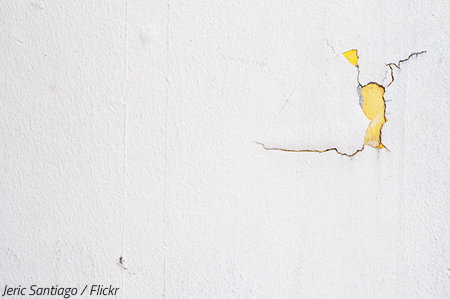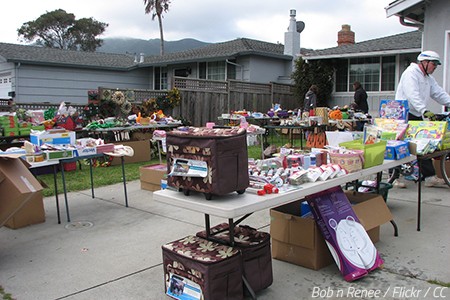If you’ve hired one of the best movers in your area, then you shouldn’t really worry too much about property damage when the hired workers are taking your large and heavy furniture out of your current home and later, taking it inside the new place.
Top professional movers have been trained on how to avoid property damage at all costs. However, if you’ve made the conscious choice to move out by yourself (for valid reasons such as moving only a short distance away, having good friends you can rely on, and having previous moving experience), then you should make sure that you do not damage in any way the house or apartment you’re leaving or the residence you’re moving into.
Not surprisingly, it’s the floors and walls that usually take a hit during a house move. Scratches, scrapes, and dents can appear in the blink of an eye unless you know exactly how to protect the property on your way out or in.
We’ve covered extensively the topic of how to protect floors during a move. Now, let’s take a closer look at the walls of the property and see what you can do to keep them perfectly intact while moving large and heavy furniture pieces.
Here are 10 ways to protect the walls in your home when moving – both indirect and direct steps to making sure the walls remain unscathed during a move.
INDIRECT ways to protect your walls
There are quite a few things you can do to protect the walls in the home in an indirect way. Don’t underestimate the importance of these safety steps as they will enable you to avoid any type of property damage whatsoever when moving house.
1. Plan your steps carefully
One of the best ways to protect the walls in your home while moving is to plan your steps well. This will enable you to not only avoid property damage of any kind – usually floor damage and wall damage, but it will also minimize the risk of personal injuries sustained during the furniture moving process.
Most furniture pieces are large and heavy, so you should never rush the job of moving furniture by yourself. Instead, spare some minutes to think of a good plan of how to take those furniture units out of the current home or inside the new one without any problems.
A good plan of action when moving furniture should include who will help you move the heavy items, how you’re going to protect them, and how exactly you’re going to transport them to the moving truck outside.
Remember: think before you act to keep property damage away from your doorstep.
2. Clear the path to the truck
If the path to the moving vehicle is not perfectly clear of clutter – most often boxes, then a person who’s guiding a piece of furniture might trip on an obstacle along the way and send the large and heavy furniture item into a wall, thus causing substantial wall damage.
This is why it’s important that the exit path out of the home remain perfectly clean and clutter-free during the moving process. To ensure this, take a walk along that pathway and make sure nothing stands in the way.
In addition to clutter, make sure the path out of the house is free of any dangerous spots such as wet spots from rain or snow that could jeopardize the safety of the furniture moving task.
20 Moving Safety Tips: Stay Safe When Moving
3. Dress properly for the job
If you think that it doesn’t matter how you dress on Moving day, think again. This is especially relevant when you’re moving heavy furniture units with your friends.
In general, what you wear in terms of clothes doesn’t matter as much as what you wear on your feet. The idea is to wear clothes that are comfortable and flexible – especially when it comes to pants. Avoid having any baggy pieces of clothing that might catch onto something and cause an accident.
Ultimately, to protect the walls when moving, you should wear shoes that are enclosed and that provide a good level of traction. You can’t go wrong if you go with sports shoes with anti-slip soles.
One thing you may not realize is that jewelry – especially large rings – could accidentally scrape a wall and leave a bad mark on it. So, don’t take any risks and take off any large rings or bracelets before moving furniture without the help of professional movers.
4. Secure enough helpers
Another way to protect walls during a move is to make sure you’ve got enough friends to help you move the furniture.
Keep in mind that wall damage, as well as floor damage or any other type of property damage, is often the result of people underestimating the seriousness of the situation and trying to move big and heavy furniture pieces either completely on their own or together with just one other person.
When moving large furniture pieces, you should have at least two other helpers by your side to support the heavy load on the furniture dolly while you’re maneuvering it out of the house. Of course, the more people there are to help during the furniture moving process, the better.
Ask your friends to help you move early enough so that you don’t ruin their own plans for the said date. However, you may still be unable to gather the necessary number of helping hands, in which case you’ll need to contact professional furniture movers to get the job done quickly and safely.
How to Get Friends to Help You Move
5. Disassemble the furniture
Oftentimes, a wall is likely to get damaged when a tall piece of furniture (a dresser, for example) or a long furniture unit (a large couch) is being moved out of the house without being disassembled first. In those cases, such oversized furniture pieces may get stuck at a sharp turn and forceful attempts to free it are likely to damage the wall corners as well.
So, one of the best ways to protect walls indirectly during a move is to disassemble large furniture to smaller units that will pass safely through door openings and corridors with zero chance of bumping into a wall.
Furniture disassembly is a required safety step when moving furniture between two homes. To avoid property damage, remove any protruding parts (legs, arms, etc.) of large furniture such as tables, beds, dressers, desks, couches, and so on.
How to Disassemble Furniture When Moving
6. Cover the furniture with blankets
Some furniture pieces cannot be safely disassembled, or you may not have the time or skills to take them apart safely. In such cases, the only way to ensure that their protruding parts won’t inflict any damage on the walls is to wrap those critical areas in bubble wrap. This way, the created extra-soft air cushion should keep things safe, both for the furniture in question and the walls inside the home.
Additionally, you should also wrap the entire furniture items in thick furniture blankets to absorb any direct hits if the units get accidentally into contact with a wall. Moving blankets (pads) will create a soft, shock-absorbing layer that will protect your valuable furniture from scratches, dents, or scuffs on the day of the move.
How to Protect Furniture When Moving
7. Use a moving dolly to keep things safe
On Moving day, you’re likely to get stuck if you have no idea what you’re doing.
It’s not a secret that moving dollies are the most trusted sidekicks of professional movers. When used properly, a moving dolly is virtually priceless in the hands of a skilled professional. So, if you’ve opted to move house without hiring a moving company, then you should also choose to use a moving dolly to wheel the big and heavy furniture items in your home.
A furniture dolly is a flat and low 4-wheel platform that can withstand hundreds of pounds of weight depending on the exact model. In most cases, you should be able to move your furniture with such a dolly but its usage has one drawback as well – furniture dollies are not meant to go downstairs or upstairs.
Secure the furniture onto the moving dolly and get at least two people to help you navigate the heavy load past walls without any damage to them.
How to Use a Moving Dolly: Furniture Dolly vs. Appliance Dolly
DIRECT ways to protect your walls
Now, here are the top 3 direct ways of protecting the walls during a move. These are must-do safety steps if you don’t have much furniture moving experience and you suspect that you may inflict some kind of property damage due to your inexperience.
8. Cover the walls with blankets or drop cloths
The best way to guarantee that the walls will remain unscathed during a house move is to cover them with protective pads. This way, even if a furniture piece bumps into a wall, the soft padding will absorb the hit and both the wall and the furniture item will remain undamaged.
Cover the walls along the exit path with thick furniture blankets or drop cloths. You don’t need to cover the entire walls, of course, but only the sections that seem to be especially vulnerable to direct hits. Don’t forget to pad the corners of sharp corners where a furniture item will have to be turned for safe passage.
Use painter’s tape to secure the blankets or cloths on the walls. However, if you find out that the pads are too heavy to be secured on the walls by masking tape, then you should consider using sheets of cardboard for the same purpose (see below).
9. Cover the walls with cardboard
It’s important to understand that cardboard is one of the most versatile materials you’ll be using during your move. Yes, your moving boxes will be made from cardboard, but you can use cardboard for a number of other things too: extra padding inside boxes, cut-outs for protecting extra-fragile items such as screens and glass elements (panels, doors, shelves, etc.), protecting floors (both hardwood floors and carpeted floors), and protecting walls as well.
The advantages of using cardboard to protect walls are that the material is very inexpensive, provides a good level of protection, and is light enough to be attached easily to the walls of the home. In addition to safeguarding walls and wall corners, cardboard sheets can be used to protect doors and door frames as well.
10. Use corner guards
Pad your furniture pieces well to protect them and keep the walls safe at the same time.
If you’re really worried that you might leave bad scuff marks on a wall while carrying furniture out of the place – for example, when moving out of a rental and not wishing to lose your security deposit, then you can place wall corner guards on the corners that happen to be most susceptible to damage.
Corner guards do offer excellent protection for wall corners but, unlike discarded cardboard sheets, they don’t come for free. You can buy a set of plastic corner guards online or get the wall corner protectors from the best home improvement store in your town or city.
Installing wall corner protectors is really easy too, so you can easily choose this way to protect wall corners when moving.
There are many things to consider when moving to a new home and one of your major concerns on Moving day is to prevent any type of property damage simply because it’ll mean more money from your own pocket for repairs. If you don’t feel confident enough to move your furniture with zero damage to the walls, then you should do the right thing and hire one of the best furniture movers in the country.
Get FREE QUOTES from top-rated furniture moving companies in your area to see whether you can afford to hire their high-quality and risk-free moving services.
The post 10 Ways to Protect Your Walls When Moving Furniture appeared first on The Moving Blog.







